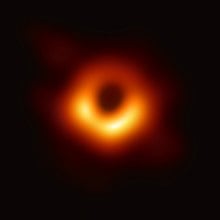Sometimes astronomers come up with awesome names for certain phenomena and then feel like they can't use them in formal scientific contexts. Tidal Disruption Events (TDEs) are one of those - colloquially they are known as " spaghettifications " where a star is pulled apart until its constituent matter looks like a string of spaghetti.
Astronomers have long known of this process, which takes place when a star gets too close to a black hole, but most of that knowledge has come through studying radiation bursts emitted by the blackhole as it devoured the star. Now, a team led by Giacomo Cannizzaro and Peter Jonker from SRON, the Netherlands Institute for Space Research, and Radboud University now think they have captured the first glimpses of a star actively being spaghettified around the pole of a black hole.
Those filaments of material have never been imaged before, as most images instances of an " accretion disk ", as the disks of material surrounding black holes are known, have been seen from edge on, meaning they appear as a band of material in front of the black hole, much as Saturn's rings would appear if they were viewed edge on. What the SRON team did for the first time was capture information about the accreditation disk while looking at one of the poles of the black hole.
Accretion disks emit X-ray radiation, but do not do so edge-on, so when the SRON team saw that they had captured X-ray signatures in their spectra, they realized they were looking at the accretion disk of a black hole from a new perspective. That perspective would be like looking down at Saturn's rings from far above the pole of the planet, finally be able to truly appreciate how many there are.
UT Video describing the process of falling into a black hole.And there truly are many strands of material wrapped around this observed black hole - the team captured separate absorption lines that would indicate there are multiple strings of material wrapped around the star multiple times. That ball of yarn pattern is similar to what would be expected to happen in a spaghettification process. Additionally, there was no Doppler shift in the data, indicating that the material was not rotating, again hinting at the underlying cause of the disk.
While the spectral data hasn't yet been translated into a pretty picture for public consumption, it does put another feather in the cap of the TDE theory of how stars interact with black holes. Let's hope astronomers can come up with some other unique names for more esoteric processes - doughification perhaps?
Learn More:
SRON - Astronomers see first hint of silhouette spaghettified star
MNRAS - Accretion disc cooling and narrow absorption lines in the tidal disruption event AT?2019dsg
UT - Astronomers Watch a Star Get Spaghettified by a Black Hole
UT - Matter is Incinerated When it Falls into a Black Hole
Tech Explorist - Astronomers see the silhouette of the spaghettified star
Lead Image:
Artist depiction of a black hole spaghettifying a star.
Credit: NASA / CXC / M. Weiss
 Universe Today
Universe Today

